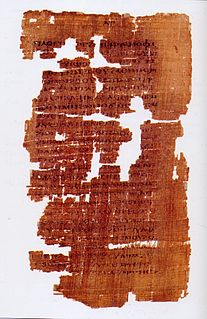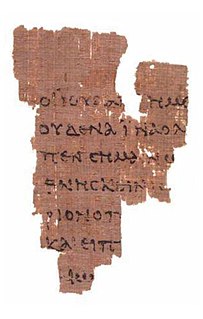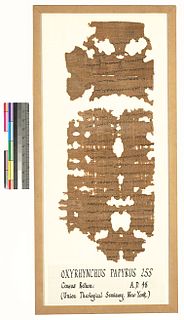Related Research Articles

The Rylands Library Papyrus P52, also known as the St John's fragment and with an accession reference of Papyrus Rylands Greek 457, is a fragment from a papyrus codex, measuring only 3.5 by 2.5 inches at its widest ; and conserved with the Rylands Papyri at the John Rylands University Library Manchester, UK. The front (recto) contains parts of seven lines from the Gospel of John 18:31–33, in Greek, and the back (verso) contains parts of seven lines from verses 37–38. Since 2007, the papyrus has been on permanent display in the library's Deansgate building.

The Gospel of Mary is a book considered non-canonical in Christian orthodoxy discovered in 1896 in a 5th-century papyrus codex written in Sahidic Coptic. This Berlin Codex was purchased in Cairo by German diplomat Carl Reinhardt.
The Berlin Codex, given the accession number Papyrus Berolinensis 8502, is a Coptic manuscript from the 5th century AD, unearthed in Akhmim, Egypt. In Cairo, in January 1896, Carl Reinhardt bought the codex, which had been recently discovered, wrapped in feathers, in a niche in a wall at a Christian burial site. It was a papyrus bound book, dating to early 5th century that was written in Sahidic dialect of Coptic, which was in common use in Egypt during that time.

The Oxyrhynchus Papyri are a group of manuscripts discovered during the late nineteenth and early twentieth centuries by papyrologists Bernard Pyne Grenfell and Arthur Surridge Hunt at an ancient rubbish dump near Oxyrhynchus in Egypt.

Papyrus 113, designated by 113, is a fragment of an early copy of a section of the New Testament in Greek. It comes from a papyrus manuscript of the Epistle to the Romans. The surviving text features parts of Romans 2:12-13 on one side of the fragment and parts of 2:29 on the other.

Papyrus 120, designated by 120, is an early copy of a small part of the New Testament in Greek. It is a papyrus manuscript of the Gospel of John. The surviving texts of John are verses 1:25-28,38-44, they are in a fragmentary condition. The manuscript palaeographically has been assigned to the 4th century (INTF).

Papyrus 121, designated by 121, is an early copy of the New Testament in Greek. It is a papyrus manuscript of the Gospel of John. The surviving texts of John are only fragments of verses 19:17-18,25-26. They are in very fragmentary condition. The manuscript paleographically has been assigned to the 3rd century by the INTF.

The Rylands Papyri are a collection of thousands of papyrus fragments and documents from North Africa and Greece housed at the John Rylands University Library, Manchester, UK. The collection includes the Rylands Library Papyrus P52, also known as the "St John's fragment", a fragment from a papyrus codex, generally accepted as the earliest extant record of a Canonical gospel.

Papyrus Oxyrhynchus L 3525 is a copy of the apocryphal Gospel of Mary in Greek. It is a papyrus manuscript formed in a roll. The manuscript had been assigned palaeographically to the 3rd century. It is one of the three manuscripts and one of the two Greek manuscripts of the Gospel of Mary. It is shorter than Papyrus Rylands 463.

Papyrus Oxyrhynchus 1 is a papyrus fragment of the logia of Jesus written in Greek. It was among the first of the Oxyrhynchus Papyri discovered by Grenfell and Hunt. It was discovered on the second day of excavation, 12 January 1897, in the garbage mounds in the Egyptian town of Oxyrhynchus. The fragment is dated to the early half of the 3rd century. Grenfell and Hunt originally dated the fragment between 150-300, but "probably not written much later than the year 200." It was later discovered to be the oldest manuscript of the Gospel of Thomas.
Papyrus Oxyrhynchus 68 concerns a dispute over a debt, written in Greek. The manuscript was written on papyrus in the form of a sheet. It was discovered by Grenfell and Hunt in 1897 in Oxyrhynchus. The document was written on 25 June 131. Currently it is housed in the John Rylands University Library in Manchester. The text was published by Grenfell and Hunt in 1898.
Papyrus Oxyrhynchus 73, is a notice of a transfer of property (ἀπογραφή), like P. Oxy. 72. However in this case the property being transferred is a slave. The document is written in Greek. The manuscript was written on papyrus in the form of a sheet. It was discovered by Grenfell and Hunt in 1897 in Oxyrhynchus. The document was written between 25 July and 28 August 94. Currently it is housed in the John Rylands University Library in Manchester. The text was published by Grenfell and Hunt in 1898.
Papyrus Oxyrhynchus 654 is a papyrus fragment of the logia of Jesus written in Greek. It is one of the Oxyrhynchus Papyri discovered by Grenfell and Hunt between 1897 and 1904 in the Egyptian town of Oxyrhynchus. The fragment is dated to the middle or late of the 3rd century. It is one of only three Greek manuscripts of the Gospel of Thomas.

Papyrus Oxyrhynchus 655 is a papyrus fragment of the logia of Jesus written in Greek. It is one of the Oxyrhynchus Papyri discovered by Grenfell and Hunt between 1897 and 1904 in the Egyptian town of Oxyrhynchus. The fragment is dated to the early 3rd century. It is one of only three Greek manuscripts of the Gospel of Thomas.
Papyrus Oxyrhynchus 252 is a fragment of a notice of removal, in Greek. It was discovered in Oxyrhynchus. The manuscript was written on papyrus in the form of a sheet. It is dated to the year 19-20. Current location of fragment is unknown.
Papyrus Oxyrhynchus 253 is a fragment of a notice of removal, in Greek. It was discovered in Oxyrhynchus. The manuscript was written on papyrus in the form of a sheet. It is dated to 25 July - 23 August 19. Currently it is housed in the Universitätsbibliothek Graz in Graz.

Papyrus Oxyrhynchus 255 is a fragment of a census return, in Greek. It was discovered in Oxyrhynchus. The manuscript was written on papyrus in the form of a sheet. It is dated to the 28 September – 27 October 48. Currently it is housed in the Union Theological Seminary in New York City.
Papyrus Oxyrhynchus 262 is a fragment of a Notice of Death, in Greek. It was discovered in Oxyrhynchus. The manuscript was written on papyrus in the form of a sheet. It is dated to 21 February 61. Currently it is housed in the Columbia University in New York City.
Papyrus Oxyrhynchus 275 is a fragment of a Contract of Apprenticeship, in Greek. It was discovered in Oxyrhynchus. The manuscript was written on papyrus in the form of a sheet. It is dated to 18 September 66. Currently it is housed in the British Library in London.

Papyrus Oxyrhynchus 282 is a fragment of a Complaint against a Wife, in Greek. It was discovered in Oxyrhynchus. The manuscript, written on papyrus in the form of a sheet, is dated between 26 January 29 – 22 May 37. It is housed in the Beinecke Rare Book and Manuscript Library of the Yale University in New Haven.